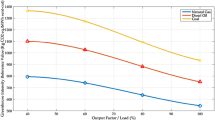Abstract
Most of electricity is produced by turbines, turned by steam from thermal generators that heating water to steam by burning different fuel, such as coal, natural gas and nuclear fuel. This paper proposed three scenarios to analyze the impact of nuclear power plant on the Egyptian electric grid from price, carbon dioxide emission, water consumption and fossil fuel consumption. The low scenario introduces the electricity generated without any nuclear plant. The basic scenario studies the expectation of the government program to 2030 that indicates the impact of first nuclear plant. We proposed the high scenario to study the impact of the nuclear power in 2030 as a double expectation of basic scenario. Wide applications of clean energy and those agreements for air environmental protection becomes an important target for the world. Analysis of the different energy resources and electricity generation fuels indicates that the nuclear energy is important for the poor fossil countries.



Similar content being viewed by others
References
Martín AD (2012) Water footprint of electric power eneration: modeling its use and analyzing options for a water-scarce future. Massachusetts Institute of Technology
Macknick J, Newmark R, Heath Robin, Hallett KC (2011) A review of operational water consumption and withdrawal factors for electricity generating technologies, Technical Report NREL/TP-6A20-50900, Task No. DOCC.1005
Sim Ralph EH, Rogner Hans-Holger, Gregory Ken (2003) Carbon emission and mitigation cost comparisons between fossil fue, nuclear and renewable energy resources for electricity generation. Elsevier Sci Energy Policy 31:1315–1326
Fencl A, Clark V, Mehta V, Purkey D, Davis M, Yates D (2012) Water for electricity: resource scarcity, climate change and business in a finite world, Stockholm Environment Institute, Kräftriket 2B, 106 91 Stockholm, Sweden
Faeth P, Benjamin K, Zoë Thorkildsen S, Rao A, Purcell D, Eidsness J, Johnson K, Thompson B, Imperiale S, Gilbert A (2014) Water adequacy and electric reliability in China, India, France, and Texas. CNA Analysis and solution
Allama RJ, Palmer MR, Brown GW Jr, Fetvedt J (2013) High efficiency and low cost of electricity generation from fossil fuels while eliminating atmospheric emissions, including carbon dioxide. Energy Procedia 37:1135–1149 (Published by Elsevier)
Wilson W (2012) A river network report “the water footprint of electricity”. Published by River Network, Portland, Oregon
Varagani RK, Châtel-Pélage F, Pranda P (2005) \(\text{CO}_{2}\) avoidance. In: Fourth Annual conference on carbon sequestration, May, 2005, Alexandria, VA Performance simulation and cost assessment of oxy-combustion process for \(\text{ CO }_{2}\) capture from coal-fired power plants
US Energy Information Egypt International energy data and analysis full report. Last Updated: June 2 (2015)
Mielke E, Anadon LD, Narayanamurti V (2010) Water consumption of energy resource extraction, processing, and conversion. Belfer Center for Science and International Affairs. Harvard Kennedy School, Cambridge
Komiyama R, kotb S (2012) Nuclear energy management school project. Tokai University of Tokyo and IAEA
Yuksel I (2015) Water management for sustainable and clean energy in Turkey. Sci Direct Energy Rep 1:129–133
Palo Alto CA (1993) Technical assessment guide, electricity supply, Electric Power Research Institute, revision 7, V.1
Cambell M (2008) The Drivers of the levelized cost of electricity for utility-scale photovoltaics. Sunpower
DeNooyer Tyler A, Peschel Joshua M, Zhang Zhenxing, Stillwell Ashlynn S (2016) Integrating water resources and power generation: the energy-water nexus in Illinois. Sci Direct Appl Energy 162:363–371
United Nations (2005) Framework greenhouse gas emissions data for 1990–2003 submitted to the convention on climate change
(1991) Modeling of integrated environmental control systems for coal-fired power plants, Report No. DE-AC22-87PC79864, Prepared by Center for Energy and Environmental Studies, Carnegie Mellon University, for U.S. Department of Energy, Pittsburgh Energy Technology Center, Pittsburgh, PA, May 1991
Saidi Kais, Mbarek Mounir Ben (2016) Nuclear energy, renewable energy, CO\(_{2}\) emissions, and economic growth for nine developed countries: Evidence from panel Granger causality tests. Science Direct Progress Nucl Energy 88:364–374
Tokimatsu K, Kosugi T, Asami T, Williams E, Kaya Y (2006) Evaluation of lifecycle CO2 emissions from the Japanese electric power sector in the 21st century under various nuclear scenarios. Elsevier 34(7):833–852
Suto M (2016) Importance of nuclear generation in the struggles to reduce CO2 emission at Kansai Electric Power Co. Dosclide
Stacy TF, Taylor GS (2015) The levelized cost of electricity from existing generation resources, Institute for energy research (IER)
(2011) International Energy Outlook, DOE/EIA 0484, September 2011
Amin Shabanpour Haghighi, Seifi Ali Reza, Niknam Taher (2014) A modified teaching–learning based optimization for multi-objective optimal power flow problem. Energy Convers Manag 77:597–607m
De Roo Guillaume, Parsons John E (2011) A methodology for calculating the levelized cost of electricity in nuclear power systems with fuel recycling. Energy Econ 33:826–839
Thoisenniklas, Kost C, Johannes N, Mayerjessica (2013) Levelized cost of electricity renewable energy technologies study
Weiner AM, McGovern RK, John H, Lienhard V (2015) A new reverse electro dialysis design strategy which significantly reduces the levelized cost of electricity. J Membr Sci 493:60–614
Singh Nirala, McFarland Eric W (2015) Levelized cost of energy and sensitivity analysis for the hydrogen-bromine flow battery. Power Sources 288:187–198
Díaz Guzmán, Gómez-Aleixandre Javier, Coto José (2015) Dynamic evaluation of the levelized cost of wind power generation. Energy Convers Manag 101:721–729
Boubault Antoine, Ho Clifford K, Hall Aaron, Lambert Timothy N, Ambrosini Andrea (2016) Levelized cost of energy (LCOE) metric to characterize solar absorber coatings for the CSP industry. Renew energy 85:472–483
Author information
Authors and Affiliations
Corresponding author
Rights and permissions
About this article
Cite this article
Kotb, S.A., Abdelaal, M.M.Z. Analysis of the impact of introduction of nuclear power plants on energy characteristics and environment in Egypt. Electr Eng 100, 285–292 (2018). https://doi.org/10.1007/s00202-016-0505-z
Received:
Accepted:
Published:
Issue Date:
DOI: https://doi.org/10.1007/s00202-016-0505-z




